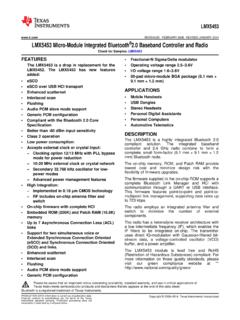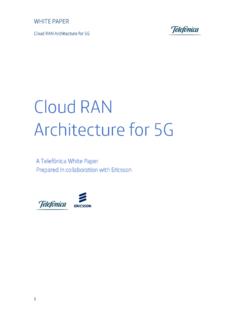Transcription of I, I Ndoii I i I~iimi.~ll W NkWDd~mn DTIC
1 AD-A260 811I, ! I I Ndoii i W I~iimi.~llNkWDd~mn__ DTICELECTE__FEB 17 1993DI/Q DEMODULATION OF RADAR SIGNALS WITHCALIBRATION AND FILTERING (U)byJim LeeApps3aVG o ftekDhubwuao Lb6 Lmnod93-02565I IH~liii 11 WHI iIH1Il!IllJ DEFENCE RESEARCH ESTABLISHMENT OTTAWAREPORT NO. 1119 Canad Deoember 1991 CanadV oft"98 2 10 028 Accesion ForNTIS CRA&MDTIC TAB 0IN, "auo W" Unannounced oDefuic. nialorale JustificationByDistribution IAvailability CodesAvail and/or)Dist SpecialDTIC QUALITY INSPECTED 3I/Q DEMODULATION OF RADAR SIGNALS WITHCALIBRATION AND FILTERING (U)byJn-m LeeRadar E" SectionElectonic Warfare DivisionDEFENCE RESEARCH ESTABLISHMENT OTTAWAREPORT NO.
2 1119 PCN December 19910111LB OttawaABSTRACTA simple in-phase/quadrature (I/Q) demodulator architecture which canmeasure the amplitude, phase and instantaneous frequency of radar signals is examined inthis report. This architecture has a potential for radar ESM applications where wideinstantaneous bandwidth and simple algorithms for extracting the modulationcharacteristics of radar signals are required. This I/Q architecture can meet therequirement by splitting an incoming signal into its in-phase and quadrature componentsusing analog hardware.
3 However in practice, there are amplitude and phase imbalancesbetween the two components and DC offsets, which can introduce large systematic errors inthe measurements. In this report, we present novel techniques which can greatly reduce thesystematic errors and improve the accuracy of the measurement. A time-domain analysisof the systematic errors is given. A calibration technique which can be used to correct forthe imbalances and offsets is discussed. The effect of noise on the accuracy of themeasurement is also examined. Imbalance errors and DC offsets of I/Q networks aremeasured and analyzed.
4 Finally, a post-processing technique employing moving averages,which is shown to be effective for improving the output signal-to-noise ratio and reducingsystematic errors, is also architecture de d~modulateur i quadrature de phase pour la mesure deI'amplitude, de la phase et de la fr~quence instantande des signaux radar est examinde dansce rapport. Cette architecture est prometteuse pour les applications de "mesures desoutien dlectronique radar" oii une grande largeur de bande instantanee et des algorithmessimples permettant d'extraire la modulation des signaux radar sont requis.
5 Cettearchitecture rencontre ces exigences en scindant, avec des composants analogiques, unsipnal d'entr&e en ses deux composantes en quadrature de phase. Cependant desdebalancements d'amplitude et de phase entre les deux composantes, ainsi que des biais detension, peuvent en pratique introduire des erreurs syst~natiques assez grandes dans lesmesures. Une analyse temporelle de ces erreurs systematiques est presentee. Unetechnique de calibration permettant de corriger les d~balancements et les biais de tensionest discut6e. L'effet du bruit sur la precision des mesures est aussi examine.
6 Les erreursdues autx d~balancements et aux biais de tension dans les d~modulateurs i quadrature sontmesur6es et analys~es. Enfin, une technique de filtrage qui permet de r&Iuire les erreurssyst6matiques est pr~sent~ SUMMARYDue to the increasing density and complexity of radar signal waveforms, it is nolonger easily possible to sort out uniquely and identify each radar emitter usingconventional signal parameters such as pulse width, radio frequency (RF), amplitude andpulse repetition frequency. As a result there is a requirement for a radar Electronic SupportMeasures (ESM) receiver to measure the modulation characteristics of radar signals and toprovide additional parameters which can be used to identify unambiguously each type ofradar emitter.
7 With the advent of fast A/D converters and high-speed digital signalprocessing technologies, it is possible to develop digital microwave receivers which canmeet this requirement. A simple in-phase/quadrature (I/Q) demodulator architecturewhich can measure the amplitude, phase and instantaneous frequency of radar signals isexamined in this report. The attractive features of this architecture for radar ESMapplications are: (i) wide instantaneous bandwidth because the negative and positivefrequencies with respect to the local oscillator frequency can be distinguished, and (ii)simple algorithms for the extraction of modulation characteristics can be used so thatnearly real-time results can be obtained.
8 However, because the splitting of the signal intoits in-phase and quadrature components is implemented using analog components, therewill be amplitude and phase imbalances between the two channels and DC offsets, whichwill introduce systematic errors to the measurement. Two techniques, compensation andlow-pass filtering using a moving average, are proposed in this report for improving thissimple effect of amplitude and phase imbalances and DC offsets is found to produceripples on the measurement and the frequency of the ripples is harmonically related to thebaseband frequency of the signal.
9 For a given set of imbalance errors and DC offsets, theerror introduced by the ripples on the instantaneous frequency is more severe and isdirectly proportional to the baseband frequency while the error is constant for both theamplitude and I/Q networks have been evaluated and the mean imbalance errors and DCoffsets over a large frequency range can be large. In order to keep the systematic errorssmall, some form of compensation is needed to remove the mean errors and offsets. Oncethe mean errors and offsets are eliminated, the residual RMS errors as a function offrequency and input power level are quite small.
10 If further improvement is required,calibration dependent on frequency and input power level may be measurement accuracy on the amplitude, phase and instantaneous frequencyhas also been analyzed and given in terms of input SNR. For large input SNR, the standarddeviation of the phase error decreases inversely proportional to the square root of the inputSNR while the standard deviation of the envelope remains constant as the input signallevel is are two basic functions performed by using a moving average. The effectivenoise bandwidth of the I/Q network can be reduced with no appreciable degradation of thesignal of interest, which will improve the output SNR.














